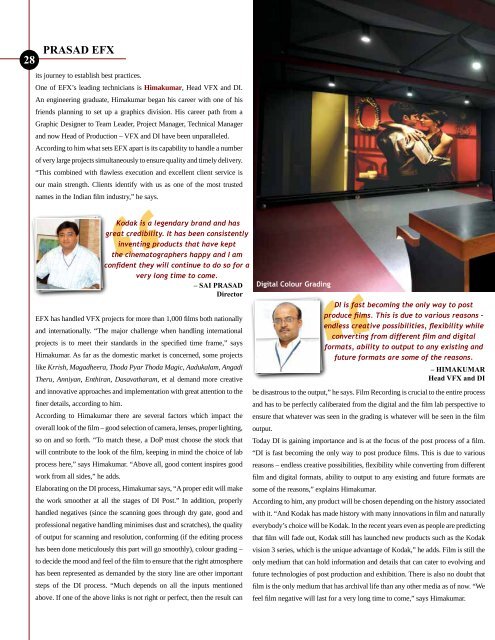READ MORE ABOUT AlsO fEATURED fOCUs ON - Kodak
READ MORE ABOUT AlsO fEATURED fOCUs ON - Kodak
READ MORE ABOUT AlsO fEATURED fOCUs ON - Kodak
Create successful ePaper yourself
Turn your PDF publications into a flip-book with our unique Google optimized e-Paper software.
28<br />
PRASAD EFX<br />
its journey to establish best practices.<br />
One of EFX’s leading technicians is Himakumar, Head VFX and DI.<br />
An engineering graduate, Himakumar began his career with one of his<br />
friends planning to set up a graphics division. His career path from a<br />
Graphic Designer to Team Leader, Project Manager, Technical Manager<br />
and now Head of Production – VFX and DI have been unparalleled.<br />
According to him what sets EFX apart is its capability to handle a number<br />
of very large projects simultaneously to ensure quality and timely delivery.<br />
“This combined with flawless execution and excellent client service is<br />
our main strength. Clients identify with us as one of the most trusted<br />
names in the Indian film industry,” he says.<br />
“ <strong>Kodak</strong><br />
is a legendary brand and has<br />
great credibility. It has been consistently<br />
inventing products that have kept<br />
the cinematographers happy and I am<br />
confident they will continue to do so for a<br />
very long time to come.<br />
– SAI PRASAD<br />
Director<br />
EFX has handled VFX projects for more than 1,000 films both nationally<br />
and internationally. “The major challenge when handling international<br />
projects is to meet their standards in the specified time frame,” says<br />
Himakumar. As far as the domestic market is concerned, some projects<br />
like Krrish, Magadheera, Thoda Pyar Thoda Magic, Aadukalam, Angadi<br />
Theru, Anniyan, Enthiran, Dasavatharam, et al demand more creative<br />
and innovative approaches and implementation with great attention to the<br />
finer details, according to him.<br />
According to Himakumar there are several factors which impact the<br />
overall look of the film – good selection of camera, lenses, proper lighting,<br />
so on and so forth. “To match these, a DoP must choose the stock that<br />
will contribute to the look of the film, keeping in mind the choice of lab<br />
process here,” says Himakumar. “Above all, good content inspires good<br />
work from all sides,” he adds.<br />
Elaborating on the DI process, Himakumar says, “A proper edit will make<br />
the work smoother at all the stages of DI Post.” In addition, properly<br />
handled negatives (since the scanning goes through dry gate, good and<br />
professional negative handling minimises dust and scratches), the quality<br />
of output for scanning and resolution, conforming (if the editing process<br />
has been done meticulously this part will go smoothly), colour grading –<br />
to decide the mood and feel of the film to ensure that the right atmosphere<br />
has been represented as demanded by the story line are other important<br />
steps of the DI process. “Much depends on all the inputs mentioned<br />
above. If one of the above links is not right or perfect, then the result can<br />
Digital Colour Grading<br />
“DI is fast becoming the only way to post<br />
produce films. This is due to various reasons –<br />
endless creative possibilities, flexibility while<br />
converting from different film and digital<br />
formats, ability to output to any existing and<br />
future formats are some of the reasons.<br />
– HIMAKUMAR<br />
Head VFX and DI<br />
be disastrous to the output,” he says. Film Recording is crucial to the entire process<br />
and has to be perfectly caliberated from the digital and the film lab perspective to<br />
ensure that whatever was seen in the grading is whatever will be seen in the film<br />
output.<br />
Today DI is gaining importance and is at the focus of the post process of a film.<br />
“DI is fast becoming the only way to post produce films. This is due to various<br />
reasons – endless creative possibilities, flexibility while converting from different<br />
film and digital formats, ability to output to any existing and future formats are<br />
some of the reasons,” explains Himakumar.<br />
According to him, any product will be chosen depending on the history associated<br />
with it. “And <strong>Kodak</strong> has made history with many innovations in film and naturally<br />
everybody’s choice will be <strong>Kodak</strong>. In the recent years even as people are predicting<br />
that film will fade out, <strong>Kodak</strong> still has launched new products such as the <strong>Kodak</strong><br />
vision 3 series, which is the unique advantage of <strong>Kodak</strong>,” he adds. Film is still the<br />
only medium that can hold information and details that can cater to evolving and<br />
future technologies of post production and exhibition. There is also no doubt that<br />
film is the only medium that has archival life than any other media as of now. “We<br />
feel film negative will last for a very long time to come,” says Himakumar.

















